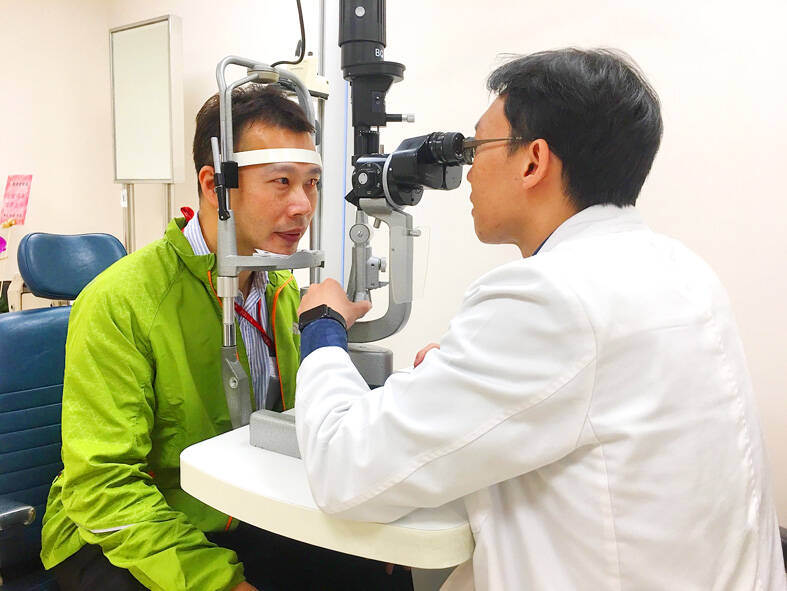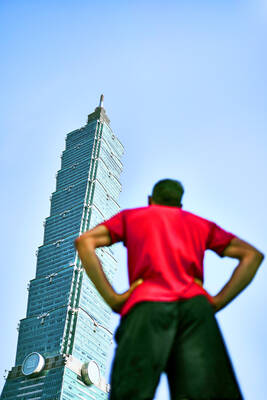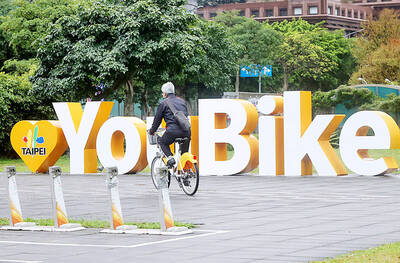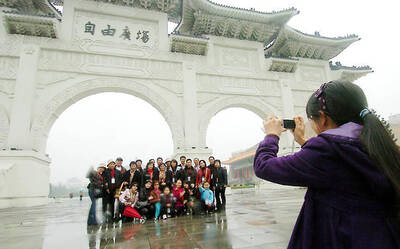The Optometry Act (驗光人員法), which stipulates that optical retailers must have an optometry clinic to perform vision tests, is to be enacted in 2026, but there is still a shortage of about 900 optometry clinics compared with optical retailers.
The act was passed in 2016 and has a 10-year grace period, so starting from Jan. 6, 2026, optical retailers must have an optometry clinic with a licensed optometrist to perform vision tests for customers or they may be fined.
However, although there is only about a year left until the act is enacted, there is still a shortage of more than 900 optometry clinics compared to optical retailers, and the national exam passing rates for optometrists and optical technicians have fallen.

Photo: Lin Hui-chin, Taipei Times
Licensed optometry clinics have increased yearly, from less than 2,000 in 2019 to 3,271 last year, or a growth rate of more than 60 percent in four years, statistics from the Ministry of Health and Welfare’s Department of Medical Affairs showed.
However, Ministry of Finance data in September showed that there are only 4,185 registered optic retailers nationwide.
Meanwhile, the number of optometrists in practice increased from 42 in 2017 to 3,779 last year and the number of optical technicians rose from 20 to 4,061 in the same period, the data showed.
However, the passing rates for the national exam for optometrists fell from 24.71 percent in 2017 to 22.66 percent last year, and from 46.57 percent to 28.52 percent in the same period for optical technicians.
Those who pass the exam still have to train and accumulate practical experience, so some eye clinics are also competing in the recruitment of optometrists.
Optometrists must pass the national examinations to perform vision tests and perform refraction tests to determine whether a patient needs a prescription for myopia, hyperopia, astigmatism or presbyopia eyeglasses and contact lenses, the act states.
Optical retailers must also obtain a license within the 10-year grace period or they might face a fine of between NT$30,000 and NT$150,000 (US$926 and US$4,628) for performing vision tests and giving prescriptions without a license.
Deputy Minister of Health and Welfare Lin Ching-yi (林靜儀) said the act accelerates the professionalization of the industry, which is required, as optical prescription involves measuring the diopters, assessing eye accommodation ability and actual visual demands, and non-professional optometrists might make the wrong judgement or are unable to detect other visual issues.
Many optical retailers have already done optometrist training in the 10-year grace period, she said.
Optometrist Society of Taiwan president Huang Chun-chen (黃群宸) said Taiwan has more optometrists than many neighboring countries, but there is a big difference between the numbers in urban and rural areas.
There are 7,840 optometrists and optometric technicians in Taiwan — an average of one per 2,935 people, which is higher than the one per 3,260 people in Hong Kong, one per 5,600 people in Singapore and one per 10,670 people in Malaysia, he said.
On average, there is one optical retailer per 3,210 people in Taiwan, so in that crowded and unhealthy competitive environment, some retailers do not want to hire an optometrist and establish an optometric clinic due to the extra cost, but they would be eliminated from the market if they cannot overcome the challenge, Huang said.
The overall optometry manpower is stable, and they should focus on improving service quality to ensure a healthy development for the optical market, he said.
Most optometrists are working in Taipei, New Taipei City, Taichung and other big cities, while Taitung County, Penghu County, Lienchiang County and other remote rural areas often have insufficient optometrists, Huang said, adding that the government should offer tax breaks to encourage more professional optometrists to work in those areas.

US climber Alex Honnold is to attempt to scale Taipei 101 without a rope and harness in a live Netflix special on Jan. 24, the streaming platform announced on Wednesday. Accounting for the time difference, the two-hour broadcast of Honnold’s climb, called Skyscraper Live, is to air on Jan. 23 in the US, Netflix said in a statement. Honnold, 40, was the first person ever to free solo climb the 900m El Capitan rock formation in Yosemite National Park — a feat that was recorded and later made into the 2018 documentary film Free Solo. Netflix previewed Skyscraper Live in October, after videos

Starting on Jan. 1, YouBike riders must have insurance to use the service, and a six-month trial of NT$5 coupons under certain conditions would be implemented to balance bike shortages, a joint statement from transportation departments across Taipei, New Taipei City and Taoyuan announced yesterday. The rental bike system operator said that coupons would be offered to riders to rent bikes from full stations, for riders who take out an electric-assisted bike from a full station, and for riders who return a bike to an empty station. All riders with YouBike accounts are automatically eligible for the program, and each membership account

A classified Pentagon-produced, multiyear assessment — the Overmatch brief — highlighted unreported Chinese capabilities to destroy US military assets and identified US supply chain choke points, painting a disturbing picture of waning US military might, a New York Times editorial published on Monday said. US Secretary of Defense Pete Hegseth’s comments in November last year that “we lose every time” in Pentagon-conducted war games pitting the US against China further highlighted the uncertainty about the US’ capability to intervene in the event of a Chinese invasion of Taiwan. “It shows the Pentagon’s overreliance on expensive, vulnerable weapons as adversaries field cheap, technologically

NUMBERs IMBALANCE: More than 4 million Taiwanese have visited China this year, while only about half a million Chinese have visited here Beijing has yet to respond to Taiwan’s requests for negotiation over matters related to the recovery of cross-strait tourism, the Tourism Administration said yesterday. Taiwan’s tourism authority issued the statement after Chinese-language daily the China Times reported yesterday that the government’s policy of banning group tours to China does not stop Taiwanese from visiting the country. As of October, more than 4.2 million had traveled to China this year, exceeding last year. Beijing estimated the number of Taiwanese tourists in China could reach 4.5 million this year. By contrast, only 500,000 Chinese tourists are expected in Taiwan, the report said. The report